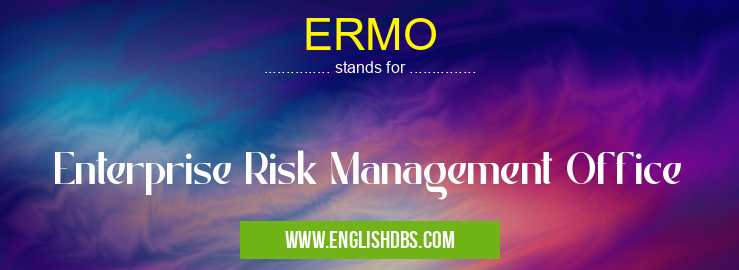What does ERMO mean in MANAGEMENT
Enterprise Risk Management Office (ERMO) is an organized approach used by companies to identify, assess, manage and monitor risks associated with operations. It is important for a business to have a risk management plan in order to protect its assets and achieve its intended objectives. ERMO uses established procedures and processes to ensure that risks are identified and managed effectively. The goal of an ERMO is to increase the probability of attaining the goals while reducing or eliminating potential losses from operational activities. This approach can help a business stay ahead of potential threats and opportunities, helping it stay competitive in the market.

ERMO meaning in Management in Business
ERMO mostly used in an acronym Management in Category Business that means Enterprise Risk Management Office
Shorthand: ERMO,
Full Form: Enterprise Risk Management Office
For more information of "Enterprise Risk Management Office", see the section below.
» Business » Management
ERMO Meaning
The Enterprise Risk Management Office (ERMO) is responsible for implementing and managing an effective enterprise-wide risk management strategy within the company. It coordinates the efforts of various departments to minimize their exposure to financial, technology, human capital, safety, organizational compliance and other types of risks. The ERMO also recommends ways to mitigate losses, such as through insurance or other measures. It monitors risk indicators across different areas of the company in order to provide early warning for any potential risks posed by operations and changes in external environment that could affect performance.
Essential Questions and Answers on Enterprise Risk Management Office in "BUSINESS»MANAGEMENT"
What is an ERMO?
An Enterprise Risk Management Office (ERMO) is a risk management department in an organization that helps identify, analyze, monitor and respond to the various risks faced by the organization. It aims to reduce the likelihood of potential risks and optimize the organizational performance by developing appropriate strategies and policies to ensure maximum protection.
How does an ERMO help organizations?
An ERMO helps organizations by identifying potential risks before they happen, providing guidance on how best to mitigate and manage those risks, proactively monitoring current risk exposure, and responding quickly to any identified vulnerabilities. By assessing and acting upon applicable risks, organizations can maintain efficiency and profitability while protecting themselves from potential incidents.
What are some examples of risk types managed by ERMOS?
ERMOS typically manage four main types of risks: strategic, operational, financial, and compliance/regulatory. Strategic risks involve changes in market demand or competitive landscape; operational risks encompass all internal operations such as logistics or resource constraints; financial risks may include currency exchange rate fluctuations or significant credit losses; and compliance/regulatory risks pertain to any applicable regulations or industry standards.
Who should be involved with enterprise risk management?
Enterprise risk management involves a variety of stakeholders including senior executives responsible for corporate strategy, internal auditors who monitor compliance with relevant laws and regulations, managers responsible for specific operations within the business processes, IT personnel (for cyber security issues), legal professionals (to address contractual obligations), board members (to oversee governance) and employees that are affected by any changes made as a result of enterprise risk management activities.
How do you determine the level of risk exposure?
The level of risk exposure is determined using a combination quantitative analysis which assesses factors like severity ratings or probability estimates associated with specific threats as well as qualitative analysis which includes looking at organizational culture, internal policies and control measures in place to support mitigating actions. The overall assessment result determines if further action needs to be taken based on its level of impact on operations or assets.
What is ISO 31000?
ISO 31000 is an international standard outlining best practices related to Risk Management. It provides guidelines for assessing an organization's overall approach towards managing its wide range of different types of risks as well as recommendations for effective implementation strategies for improving existing processes while maintaining a balance between objectives set out by senior leadership alongside practical realities like available resources.
What are preventive controls?
Preventive Controls are measures taken ahead of time in order to minimize potential threats before they occur. This could range from implementing access control systems on computers used for sensitive information processing or monitoring employee activity within the company networks through employee tracking software programs. Preventive controls provide more certainty that security measures will effectively work when needed rather than reacting after the fact when damage may have already been done.
What is meant by monitoring controls in enterprise risk management?
Monitoring Controls refer to systematic reviews performed periodically that track the effectiveness of procedures put in place during earlier stages like plan development or implementation phases. This could include examining performance metrics such as completion times for tasks created through project plans or incident notifications received over past months with details pertaining to alternative solutions employed preventing potential losses due to identified vulnerabilities during system scans performed regularly.
Final Words:
Risk management is essential for businesses’ success and survival; without it businesses would be exposed to both minor day-to-day issues as well as more significant threats which could derail their operations entirely. By having an Enterprise Risk Management Office (ERMO), companies can identify existing as well as potential risks, create strategies for managing these risks effectively, and maintain a level of preparedness if they should come across them during their course of business. Not only does this benefit companies directly by protecting them from loss; it also provides assurance that they are meeting legal requirements related to safety and compliance regulations which can then help protect customers as well.
